Visiting Shakespeare's Stratford-upon-Avon
by Pearl Harris
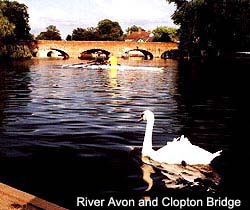 This historic market town situated on the banks of the River Avon in Warwickshire, notwithstanding its fame as the birthplace and final resting place of William Shakespeare, must surely rank as one of Britain's loveliest towns. This historic market town situated on the banks of the River Avon in Warwickshire, notwithstanding its fame as the birthplace and final resting place of William Shakespeare, must surely rank as one of Britain's loveliest towns.
The name "Stratford" means "street ford". This derives from Roman times when there was a ford over the Avon at the point where the road crossed the river (today this road is the A422 to London).
In 1196, John de Coutances, the Bishop of Worcester, decided that the part of his estates near the "strete ford" where the Roman road from Banbury crossed the River Avon, should become a town. He laid out his plan for the town of Stratford-upon-Avon on a grid system, according to the ancient Roman pattern, which is still used today by modern town planners.
The Bishop of Worcester also granted his tenants the right to rent property and pass it on as an inheritance upon their death. This was known as "burgage" tenure. Each plot or "Burgage" was approximately a quarter of an acre in area. The tenants, known as "burgesses," paid one shilling per year in rent, for which princely sum they were allowed by the Bishop, their overlord, to trade freely.
It was also in the year 1196 that the Bishop of Worcester obtained a special Charter from King Richard I for the town to hold a weekly farmers' market in order to attract merchants from other parts of the country. This market tradition has continued to the present time, with weekly markets still held in the historic town center.
Stratford-upon-Avon was also an important halt for stage coaches between London, Oxford and the North. In medieval times, the Avon was spanned by a wooden bridge. This was replaced in the 15th century by the Clopton Bridge, a much-photographed stone bridge still in use today. The Clopton Bridge was named for the wealthy Stratford merchant, Hugh Clopton, who financed its construction and who later went on to become Lord Mayor of London.
Stratford entrances with its natural scenic beauty, its graceful swans, weeping willow trees and shady riverside walks. Above all, it is a town permeated by the spirit of William Shakespeare. It is impossible to ignore that this is where, in 1564, he was born and spent his early years and where, in 1616, he died. Admirers, scholars and tourists from around the globe make pilgrimages to Stratford to retrace the footsteps of the Bard of Avon.
The Shakespeare Birthplace Trust owns and maintains the historic houses relating to Shakespeare and his family. This is an independent charity, obtaining its funds entirely from the public. Multiple House Tickets are available for all five Shakespeare houses.
Shakespeare's Birthplace
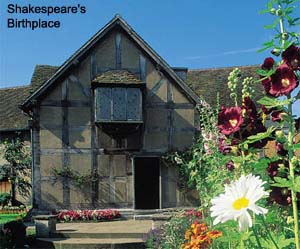 Of the five Trust Houses that encompass the life of the Bard, the most frequently visited is, naturally, the house where he was born in Henley Street in the heart of Stratford. Eight rooms are open to the public, containing documents, portraits and other items of historical interest. If you sign the Visitors' Book here, you will be following the example of Dickens, Tennyson, Hardy, Keats and Scott -- all of whom have signed it in the past! Of the five Trust Houses that encompass the life of the Bard, the most frequently visited is, naturally, the house where he was born in Henley Street in the heart of Stratford. Eight rooms are open to the public, containing documents, portraits and other items of historical interest. If you sign the Visitors' Book here, you will be following the example of Dickens, Tennyson, Hardy, Keats and Scott -- all of whom have signed it in the past!
The spacious, beautifully restored half-timbered house is actually two dwellings combined. The west half is fitted out with the furnishings of a 16th century home with a glove-maker's workshop, where Shakespeare's father (although of uncertain profession) is thought to have worked. Alternate theories put John Shakespeare as a butcher, wool merchant or corn trader. The east half of the house was purchased by John Shakespeare in 1556 and contains period furnishings and artifacts of the 16th century. The garden features many plants, herbs, fruit trees and shrubs. The Birthplace Museum is a modern building attached rather incongruously to the half-timbered Shakespeare home. A ticket to the Birthplace includes entry to the Exhibition of Shakespeare's Life, where one may see the first edition of his Complete Works amongst other interesting memorabilia of his life.
Thousands of visitors come to Stratford-upon-Avon daily to pay homage to its illustrious son, yet his life remains an enigma. Many scholars believe that "William Shakespeare" was merely a nom de plume and that the famous sonnets and plays were not written by him at all! The American novelist Henry James once said, "I am haunted by the conviction that the divine William is the biggest and most successful fraud ever practised on a patient world." Among the long (and sometimes ludicrous) list of people suggested as having been the author of Shakespeare's works are Christopher Marlowe, Ben Jonson, Francis Bacon, the Earls of Rutland, Oxford and Southampton and even Queen Elizabeth I.
There are indeed many unanswered questions regarding Shakespeare. How could a man of such modest background have such an intimate knowledge of Royalty? How could he know so much about Italy (the setting for many of his plays) if he had never been there? Why did he not leave a Library in his Will? Even more baffling, no death notice or obituary was published at the time of his death -- almost unbelievable had he been such a successful and well-known playwright! How could a man of limited formal education have left such a legacy of monumental literary works for future generations? We shall never know these answers, but should merely be grateful for the timeless heritage of William Shakespeare (or somebody writing in his name!).
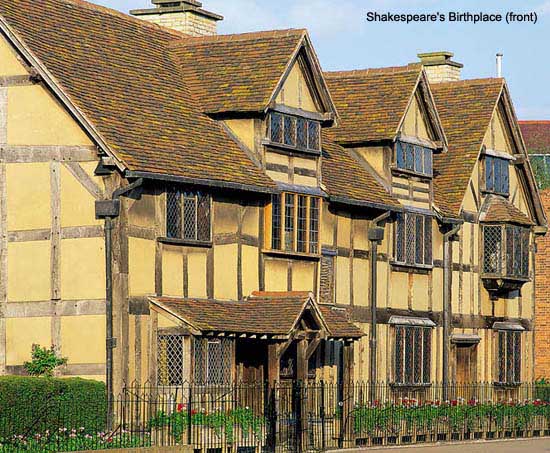
The little concrete evidence available about the man himself comes from the official records of his baptism, marriage and death. It is known that he was the first-born of John and Mary Shakespeare and that he attended the local Grammar School until the family's financial problems forced him to join his father in business. Although we do know that William's mother was Mary Arden, daughter of Robert Arden, a yeoman farmer, it is not entirely certain that Shakespeare was indeed born in the Henley Street house or in fact what the exact date of his birth was. The only definite proof of his birth we have is the record of his baptism on 26th April, 1564.
We know that he married Anne Hathaway, 7 years his senior, when he was just eighteen. Five months later, a daughter, Susanna, was born to the couple. Between 1583 and 1585 they had 3 children, one of whom died in 1596.
In about 1587, William was caught poaching on Sir Thomas Lucy's estate at Charlecote and fled to London, apparently with a group of travelling players. His life becomes sketchy at this point, during which time he is claimed to have been, amongst other things, an actor, a playwright, a soldier, a schoolmaster, a spy and a studying Catholic!
In 1594, his name appears in the records of "The Lord Chamberlain's Men" as a working actor in Shoreditch, London, and as author of plays at the Theatre, the Rose and the Curtain. In 1599 "The Lord Chamberlain's Men" moved their Theatre to Southwark's Bankside and renamed it The Globe. In 1603, The Globe acquired Royal patronage. At the time of the accession of James I, "The Lord Chamberlain's Men" changed their title to "The King's Men".
During this period of theatrical boom in London, William Shakespeare's output was prolific. Between the late 1580s and 1613, he wrote approximately forty plays, most of which were performed by his own theatrical group in The Globe.
Shakespeare's success gained him friendship and connections in high places, among whom Henry Wriothesley, Earl of Southampton (thought to have been Shakespeare's "golden youth" portrayed in his Sonnets). He realized the importance of playing to the rich and famous, earning through his plays enough to retire in comfort to Stratford where he concentrated on family and business affairs during the last few years of his life. His flow of writing ceased in 1613, the same year in which The Globe burnt down.
William Shakespeare died on St. George's Day in 1616, on what is assumed to have been his 52nd birthday.
Despite -- or maybe even because of --the aura of mystery surrounding the life of the Bard, it is the evergreen words of wisdom, wit and beauty that remain indelibly etched on the pages of world literature for eternity that is his most immortal legacy. It is a sad fact of humanity, however, that the majority of the millions of tourists who annually traipse through Shakespeare's and his family's former residences have probably never read any of his immortal words!
Anne Hathaway's Cottage
Second only to Shakespeare's Birthplace, the most visited historic home is undoubtedly the home of Anne Hathaway in the village of Shottery, one mile from Stratford. Most visitors travel to the cottage by tour bus, car or local bus. If you approach the cottage on foot from the local bus stop, you will follow a pleasant forest path beside a bubbling stream until you reach the cottage itself.
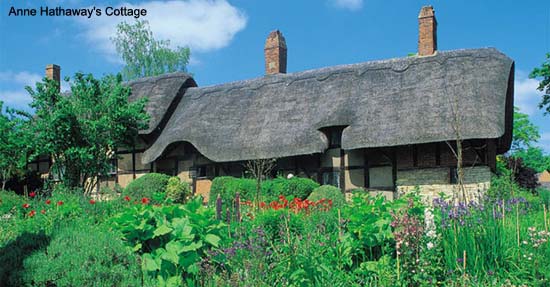 This is a picture-perfect English thatched cottage in a luxuriant country garden. Upon entering the cottage, you will see the "courting chair" in the room where Shakespeare is reputed to have courted Anne. Many artifacts, furnishings and pottery related to the Shakespeare and Hathaway families are on display. In the colorful garden you will see the Elizabethan maze and the Shakespeare-inspired sculptures by contemporary British and American sculptors.
Nash's House and New Place
Nash's House and New Place, the third of the Shakespeare Trust houses are situated a short walk from the center of Stratford in Chapel Street. Nash's House is the home where Shakespeare's granddaughter, Elizabeth Hall, lived with her wealthy husband, Thomas Nash. The adjacent garden contains the foundations of New Place, the house which Shakespeare bought in 1597, retired in and where he died.
New Place itself was unfortunately demolished in the 18th century by its irate owner, Rev. Francis Gastrell, who was so pestered by Shakespeare fans that he first of all chopped down a mulberry tree which William was thought to have planted in the garden, before demolishing the entire house! A fairly radical method of getting rid of sight-seers, it might be thought!
You may see the Guild Chapel and School, which Shakespeare is said to have attended in nearby Chapel Lane. The Guild of the Holy Cross, a religious fraternity founded in 1269, provided a hospital and almshouses and also tended to the education of young boys.
The Guildhall was built at the beginning of the 15th century, to be used as a feast hall. The Schoolroom was originally in the Schoolhouse, which was added in 1427. Now known as the Pedagogue's House, this is the oldest surviving half-timbered schoolhouse in Britain and is still used by the present day King Edward VI Grammar School.
Despite the enormous amount of good they did, the Crown set about dissolving the Guilds for fear of the great power they wielded. The Guild of the Holy Cross in Stratford was dissolved in 1547, a few year later its buildings and assets were transferred to King Edward VI's commissioners. Thereby a "Free School" was established, named "The King's New School of Stratford-upon-Avon".
The Borough Corporation occupied the ground floor conference room and the Schoolroom was located on the upper floor. William Shakespeare was one of the first boys to have been educated at "The King's New School", starting his schooling at approximately the age of 7. The curriculum of the day would have been dominated by Greek and Latin. Great classical authors would have been studied and discipline strictly upheld. Boys were punished if they spoke to each other in English and not Latin.
This Schoolroom is now part of the King Edward VI Grammar School. A plaque on the wall bears the inscription that William Shakespeare studied here. Shakespeare is thought to have left at the age of 13 to work for his father -- a year before the normal school leaving age, due to financial pressure on his father.
Harvard House in High Street is one of Stratford's best-kept secrets and a superb example of an Elizabethan town house. Of special interest to Americans is the fact that this is the former residence of the mother of John Harvard, founder of Harvard University. It now houses the Museum of British Pewter with an extensive and unique pewter collection dating back fifteen centuries.
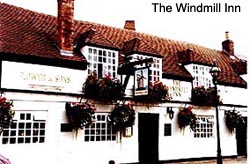 Another well-kept secret is The Windmill Inn in Church Street, just around the corner from Nash's House. This traditional pub with its original oak beamed interior is a listed building, frequented by locals and as yet strangely undiscovered by the majority of tourists. The carved inscription on an oak beam reads: " This house was built in 1599 and became an Ale House a year later." Another well-kept secret is The Windmill Inn in Church Street, just around the corner from Nash's House. This traditional pub with its original oak beamed interior is a listed building, frequented by locals and as yet strangely undiscovered by the majority of tourists. The carved inscription on an oak beam reads: " This house was built in 1599 and became an Ale House a year later."
This friendly pub with its colorful flower boxes is almost certain to have been one of Shakespeare's haunts, situated as close as it is to his last residence at New Place. Good food, real ale, reasonable prices and the all pervading spirit of William Shakespeare, pondering over the lines of his latest Sonnet over a pint at the bar, make a visit to The Windmill a special event.
Halls' Croft
This is the 4th of the Shakespeare Trust homes. One of the town's most impressive medieval homes, this mansion was the residence of Shakespeare's daughter, Susanna, and her physician husband, John Hall.
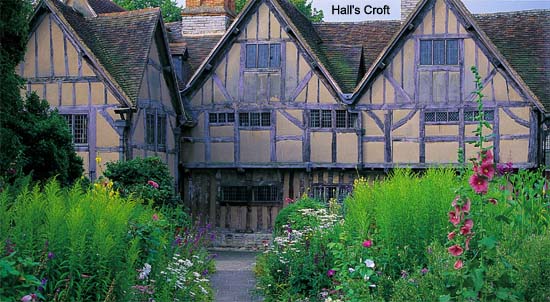
Lovingly maintained, Hall's Croft contains period furniture, the doctor's consulting room and an absorbing exhibition of Elizabethan medicines and medical instruments. Some of Dr. Hall's case studies were published in the volume, Select Observations on English Bodies. In Hall's Croft you may study Dr. Hall's fascinating case notes in his notebooks which are on display. The formal garden contains many of the herbs and plants mentioned in the doctor's notes.
Mary Arden's Home
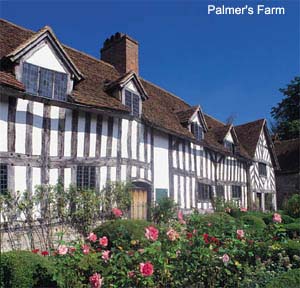 The 5th Shakespeare Trust home, that of Shakespeare's mother, is situated three miles northwest of Stratford in the Forest of Arden at Wilmcote. The 5th Shakespeare Trust home, that of Shakespeare's mother, is situated three miles northwest of Stratford in the Forest of Arden at Wilmcote.
Mary Arden was the only unmarried daughter of Robert Arden, a working farmer, known as a Yeoman, who owned his land. When Robert died in 1556, he left the house to Mary. As it was most unusual at that time for a daughter to inherit property, she became one of the most eligible spinsters of the neighborhood. A year later, she married John Shakespeare.
Mary Arden's home is a fine example of a well-furnished Elizabethan farmhouse with everyday household items of the period on display in the ground floor rooms. At adjoining Palmer's Farm, one is given a rare glimpse into 16th century rural life.
The Shakespeare Countryside Museum, with its refurbished farm buildings and working organic farm stocked with rare breeds such as Longhorn cattle and Gloucester Old Spot pigs, makes absorbing viewing. Falconry displays are another fascinating event staged for visitors.
This is a pleasant outing in the countryside for the whole family. Take a walk across the nearby Warwickshire fields while the children enjoy the adventure playground.
After a pilgrimage to the five Shakespeare Houses, it is only appropriate to attend a performance of one of his plays in the Royal Shakespeare Theatre on the banks of the Avon. Stratford-upon-Avon is home to the renowned Royal Shakespeare Company (RSC), long recognized as the world's foremost classical theatrical company.
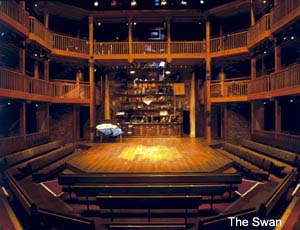 There are actually no fewer than three Shakespeare theatres in Stratford today, whereas, ironically there was no theatre at all in the town in Shakespeare's day! The first festival in his honor to be held in his hometown was in 1769, whereafter the idea was promoted to build a memorial theatre. In 1879, the first Memorial Theatre opened on land donated by Charles Flower, a local beer baron. There are actually no fewer than three Shakespeare theatres in Stratford today, whereas, ironically there was no theatre at all in the town in Shakespeare's day! The first festival in his honor to be held in his hometown was in 1769, whereafter the idea was promoted to build a memorial theatre. In 1879, the first Memorial Theatre opened on land donated by Charles Flower, a local beer baron.
A fire in 1926 caused terrible destruction to the theatre and subsequently an architectural contest was held to design a new theatre. Elizabeth Scott won this competition and it is her creation which we see today in the form of the large, red-bricked modern edifice on the banks of the Avon.
The Royal Shakespeare Theatre is the venue for Shakespeare's works, with an occasional performance of another playwright's work. With the world's leading actors on stage and top directors behind the scenes, seeing a Shakespeare play performed here is an unforgettable part of any visit to Stratford-upon-Avon.
The two other RSC theatres are The Swan and The Other Place. The Swan was built in the 1980s on the site of the original burnt-out theatre and is designed as an "in-the-round" Elizabethan theatre. It stages works by Shakespeare's contemporaries, classics from other eras and an annual play by the Bard himself. The Other Place is used for productions of experimental and modern drama.
The RSC, established in 1961, hosts a number of theatre tours and lectures to the public. The RSC Collection housed upstairs at the Swan includes gloves owned by actor David Garrick and the famous "Flower" portrait of Shakespeare. The RSC works on a repertory system, so you may see four or five different plays if you stay in Stratford for a couple of days. However, the most popular plays are booked up for months ahead. The RSC box office sells tickets for all three theatres.
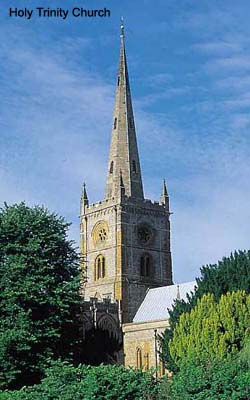 Take a peaceful stroll along the banks of the Avon to Shakespeare's final resting place in the Holy Trinity Church. The sanctuary knocker on the inner door of the porch dates back to the 13th century. At that time, any fugitive from justice could claim Sanctuary within the Church for a period of 37 days, after knocking on the door and gaining entry to the Church. Take a peaceful stroll along the banks of the Avon to Shakespeare's final resting place in the Holy Trinity Church. The sanctuary knocker on the inner door of the porch dates back to the 13th century. At that time, any fugitive from justice could claim Sanctuary within the Church for a period of 37 days, after knocking on the door and gaining entry to the Church.
Shakespeare became a lay rector at the Holy Trinity Church in 1605; hence he was given the privilege of being buried in its chancel in 1616. His grave is marked by a simple stone slab, next to which are the graves of his wife, Anne, and other members of his family. On the north wall is the bust of Shakespeare, which was erected within seven years of his death.
The High Altar was the original altar in the chapel of St. Thomas a Becket and still bears four of the five consecration marks denoting the five wounds of Christ. The chained 1611 Bible from which the Bard would hear the Lessons read during the last six years of his life is on display, as are photocopies of parish registers of his baptism and burial. The visitor may also see the 15th century font at which Shakespeare was probably baptized.
The tranquil churchyard is typically English, idyllically situated on the river bank, beneath graceful weeping willow and yew trees. Take a rest on a shady bench and watch the swans glide by while contemplating the riddle of Shakespeare's life.
You will find this very special town in the heart of England on the River Avon, eight miles downstream from Warwick. If you are able to visit only one town in the whole of Britain, you will not be disappointed if your choice falls upon Stratford-upon-Avon!
Related Articles:
- The Globe Theatre: London's Wooden "O", by Elise Warner
- https://www.timetravel-britain.com/articles/london/globe.shtml
More Information:
We regret that we no longer have the resources to maintain up-to-date links and/or hours and pricing details for the various sites and attractions listed on this website. For more information about the location(s) listed above, please use your favorite search engine or visit Wikipedia.
Pearl Harris, whose ancestors hail from Britain, was born in South Africa. In 2002, she emigrated to the Czech Republic with her husband, their dog and cat. Pearl resides permanently in the Czech Republic where she works as a freelance travel writer, English teacher and proof-reader. Her main passion is travel. Having traveled extensively in Africa, Europe,the USA and UK, she never intends to stop. Other interests are pets, photography, reading and writing. Pearl, a retired Diagnostic Radiographer, has a B.A. in English and Linguistics, post-graduate Diploma in Translation and TEFL qualification. Her only daughter, a professional photographer, lives in New Orleans.
Article © 2006 Pearl Harris
Windmill Inn and Clopton Bridge photos © Pearl Harris; additional photos courtesy of the Warwickshire Tourist Office.
| 